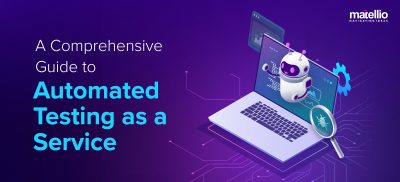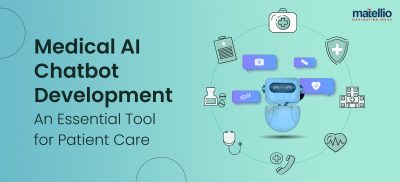
Undoubtedly, we live in a fast-paced economy. If a product doesn’t reach consumers at the correct time, businesses may miss out on valuable chances.
Today, many businesses and their teams are dissatisfied with their test coverage and maintenance expenditures. Simultaneously, without tangible business KPIs, it’s difficult for teams to value the hours spent building test cases.
But,
The role of the QA team has undoubtedly evolved as a result of DevOps. QA used to be solely responsible for functional testing and regression once a solution was released.
In this blog, we’ll look at why the coupling of automation testing and DevOps may work miracles for today’s modern software companies.
Key Takeaways:
So, let’s begin!
What is DevOps?
DevOps is a term that includes the terms development and operations. It refers to a collection of procedures for reducing software release cycles by delivering high-quality software on a continuous basis.
The Agile methodology serves as the foundation for many parts of DevOps. Software companies can offer high-quality goods and services at a faster rate by incorporating DevOps.
Why is Software/App Testing Important?
Only by guaranteeing that the development, testing, and deployment processes are done flawlessly; product upgrades be rolled out quickly. The development team’s improvements must go through a thorough testing process.
Manual testing will not be sufficient to complete these responsibilities since it will not be able to keep up with the Agile objectives.
Moving forward, let’s talk about some reasons why testing is important! So, take a look:
| Some Reasons why Testing is Important |
| There is no time for proper manual tests or disorganized automated tests because release cycles have become significantly shorter. Many businesses are adopting continuous delivery, which entails distributing new software versions instantaneously. |
| Developers are finding it more difficult to track down faults as software designs get more sophisticated. |
| Helps to avoid the extra cost. |
| Software testing is cost-effective. |
| As software and business are so intertwined, a software failure is also a business failure. When a company’s livelihood is dependent on software, any downtime may be tremendously costly in terms of lost revenue and reputation. |
| The user receives a reliable software product. |
As you have seen, some points stating the importance of software testing. Now, let’s move forward and check.
Test Automation and DevOps!
To accomplish such speed and strength, all testing activities must be automated and configured to execute automatically once the installation in the QA environment is complete. To accomplish this integration, specialists in Automated Testing tools and continuous deployment tools are required. Businesses may readily cater to client requests for software updates in a short amount of time using DevOps. DevOps, therefore, entails performing a set of testing methods that, if performed manually, would be time-consuming and prone to errors due to the laborious nature of the job.
To get the most out of DevOps and Automation Testing, employ test automation services from professional providers like Matellio to get the maximum.
Moving on, let’s talk about,
What are the Benefits of Incorporating Test Automation and DevOps?
Top benefits of incorporating test automation and DevOps:

1. Higher Consistency
To stand to gain the benefits of DevOps, consistency in test results is required.
When the program is tested against multiple input configurations, consistency in the QA findings implies that the system continues to work on the up and up. This level of consistency should be maintained throughout the delivery process. The only method to validate software across multiple inputs at various stages while reducing the risk of human mistakes is to automate the testing process.
2. Ensures Better Communication and Collaboration
Integrating Automated Testing into the development and operations cycle is more than just a buzzword; on the programming desk, it means constant and close communication across multiple teams, as their jobs frequently cross or are interdependent. People working on development, for example, might gain a sense of the product’s expectations earlier in the process than when it’s ready for delivery. This allows them to incorporate recommendations and potential pain areas into the coding process, thereby improving the product’s quality.
3. Ensures Testing on Various Forms
Cross-browser monitoring, load testing, spike screening, regression testing, and other sorts of testing are all covered by automation testing. Though the type of testing used is entirely dependent on the product, the goal should be to run the tests on a large scale.
Almost all test automation solutions can be connected with popular continuous integration and delivery (CI/CD) tools. This aids in the verification of software modifications from many perspectives, ensuring that higher-quality software hits deployment.
4. Faster Time-to-Market
DevOps is based on the integration of all processes, including testing, in order to provide a speedier delivery. Customers nowadays expect problem fixes or software upgrades to be implemented quickly in response to their comments. That is addressed by the combination of DevOps and Test Automation.
Even if the test cases are complex, such as in the case of a particular software update or if numerous tests must be run concurrently, DevOps in automation testing allows for speedy test results.
5. Ensures Best Outcomes
The ability to build automated tests for automating both simple and complex test scenarios is a major benefit of automation tests. Parallel test execution is a functionality found that nearly most test automation frameworks enable, allowing QA professionals to evaluate features against a variety of test combinations. These test scripts can indeed be used to test product features before they are delivered to QA.
Top Tips for DevOps Testing!
Top tips for successful implementation of DevOps in automation testing are:
1. Choose the Right Frameworks
Test automation strategies rely heavily on frameworks. They offer modules that may be used by multiple teams to develop custom automation tests.
A well-designed testing automation suite may be a valuable asset to your company and an important aspect of DevOps. It encourages quicker delivery, early discovery of problems and makes the process of continuous updates and execution easier. Instead of focusing solely on technology, frameworks for your automated test approach allow you to concentrate on user value. It allows the team to think beyond the actual implementation of software and provide better service to the end-user. During DevOps, properly deployed test automation frameworks significantly mitigate test suite ongoing costs.
2. Grasp the Ins and Outs of the Product
For efficient DevOps, understanding the test automation needs and picking the correct set of tools to use isn’t enough. Every part of the software’s user environment, including its configurations, framework, end-user purpose, security parameters, and so on, must be understood.
The better you comprehend the software, the quicker it will be for you to select the appropriate automation tools for security testing during DevOps. Efficiency of DevOps in automated testing can be achieved by keeping the automated testing team informed about any application updates. It will not only enhance the software testing process but will also help teams communicate more effectively.
3. Define Small Test Cases
Even though some quality analysts strive to create huge test cases to address complex code architectures, it may be more useful to keep your test cases modest.
You will indeed be able to identify each testing and set a clear explanation of the intended outcome if you build short test cases. Then you’ll know exactly what went wrong or right. The test cases will be considerably more straightforward and understandable. While it is critical to keep your test cases small, negative test scenarios must also be considered. To achieve better software security, security teams frequently develop negative test cases in which a user ought not to be able to access another user’s data or abuse input validation. This aids in the detection of erroneous data or unusual user behavior in your DevOps strategy. As a result, smaller testing processes for DevOps testing focus on accurate validation, reducing the risk of application vulnerabilities. It promotes improved learning and understanding among multiple teams, allowing them to work together more effectively.
4. Choose the Right Tools
When it comes to test automation, picking the correct tools is critical. Automation testing is the most effective technique to improve software application quality and productivity, but using the wrong tools can indeed have a negative impact on the entire process. Your organization’s ability to deliver high-speed software and services will be determined by the decisions you make.
There’re various tools available in the market, each with its advantages and disadvantages, but no single tool can meet all automated testing requirements.
5. Hire the Right DevOps and Automated Testing Service Providers
If you are novice to DevOps and looking for help, it is very important to collaborate with the best DevOps and Automated Testing service providers; because they have the best and right expertise and experience to tackle all your software problems. If you’re looking for such providers, then look no further and contact us. We can help!
Conclusion
Automation Testing, particularly in DevOps, can help Testers tackle complicated challenges and go beyond the pain of intensive testing. For the benefits it provides, it acts as a backbone to the DevOps technique. DevOps in automation testing may help ensure that the highest-quality software is delivered to end-users. It is critical to contact top test automation service providers that provide test automation services, regardless of the size of the company. This will help in the development of a safe strategy that combines the best of DevOps and test automation.





